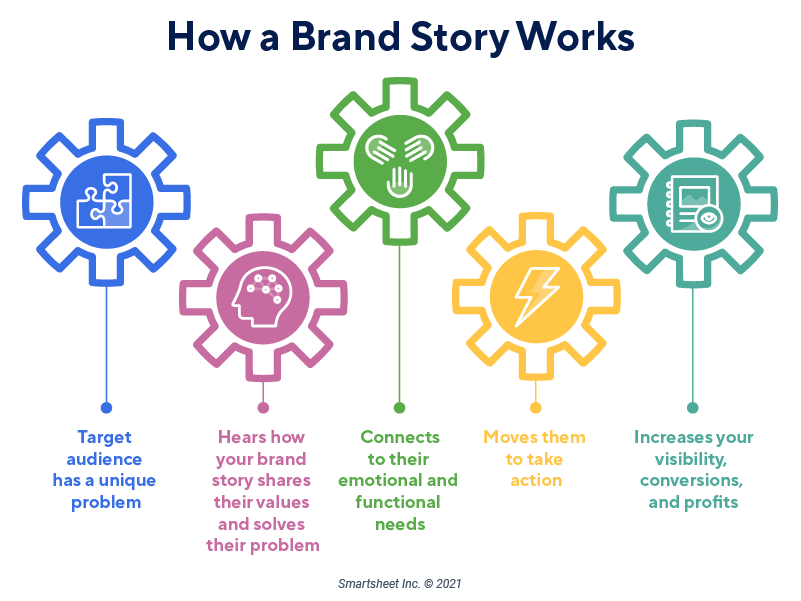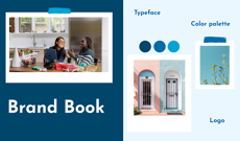When you hear that nowadays people don’t want to buy from no-names, and you need to build your brand and tell your brand story to convince them to do business with you, it’s true. But only half-true.
It’s not nowadays. It’s always been like that—for millennia, stories have been the main way for us to learn, connect with other people, and—buy. Before mass production came around, we mainly bought local, from people whose stories we knew personally, or through word-of-mouth. It was just a natural order of things.
What changed was the arrival of globalization which made it so much easier to buy anything, but also so much more difficult to learn who you are buying from. Plus, people now are well aware of the harm some big corporations are doing and often don’t want to support unethical business practices, which makes brand stories more important than ever.
In this article, we’ll look at what a brand story is, what benefits it gives your company, and how to craft a compelling story using digital storytelling methods.
What Is a Brand Story?
Brand story isn’t the same as brand history. True, it often explains how the brand came to be. However, it also reflects the brand’s values and purpose and creates a narrative that resonates with the customer.
A good brand story doesn’t just state dry facts. Much like your favorite book, it has a protagonist and a dramatic conflict, recounts the struggles the main character (aka your brand) overcomes, and how they shape your vision and mission. It makes you if not fall in love with the brand, then at least relate to its story.
Your brand story doesn’t have to be long or epic, but it should be concrete to hit home. Take Hubspot, for example. Their brand story is three paragraphs long. However, those three pieces clearly state the problem: marketers and salespeople have been harassing buyers for too long. And the mission: to create and spread marketing practices that are helpful, not harmful. We’ve all been bullied by aggressive ads and noisy reps at some point, so this idea is very compelling, indeed.
Benefits of a Brand Story
We have already established that brand stories help to build a connection with customers. But let’s look at the benefits they give you a bit more closely.
1. Setting you apart from competitors
A brand story with a clear message shows customers how you are different from other companies with similar products. And a distinct identity is extremely important in the world, oversaturated with goods and services where a colorful logo or a catchy tune isn’t enough to make buyers remember you.
2. Brand consistency
A compelling and clear brand story serves as a backbone for your marketing strategy and communications. Tying back your content pieces to the core narrative helps ensure your brand messaging and image stay cohesive. Which, in turn, is important for shaping a strong brand identity.
3. Trust and credibility
Sharing your values and mission helps show the human side of your company: real people with real beliefs behind the business. When buyers perceive your brand as authentic, they are more inclined to trust it and stay loyal to you and your products. 94% of buyers say they recommend brands they have an emotional connection with.
4. Deeper engagement
This benefit is not so obvious because the brand story alone won’t keep people on your site or your product longer. However, if you make it a part of your messaging, people will be more eager to consume the content you create for them, be it email campaigns, videos, presentations, or even promotions. After all, you are always happy to hear from a good friend, aren’t you?
5. Keeping everyone on the same page
Having a well-crafted brand story not only benefits your client communications but also helps to unite people within the organization. Working toward a common goal and sharing the same values nurtures a strong sense of community and camaraderie.
6. Shareable content
Good stories catch on like wildfire. If people find your story likable enough, they will repost it on social media, giving you more brand recognition and possibly an SEO boost.
Well-crafted brand story examples
Big or small, old or new, all successful brands tell their story. Here are a few of the masterpieces of recent times.
Airbnb: the sense of belonging

Airbnb was born in 2008 from two broke students’ wild idea to rent a mattress on the floor of their apartment to get some cash for bills. While this is an amusing anecdote that certainly elicits an emotional response and a chuckle, it wasn’t enough to captivate the public with the idea of sharing their apartments with strangers—or staying at a stranger’s house for that matter.
So as the company and community around it grew, Airbnb felt they needed to find a new purpose that would resonate with people. They turned to the customers who already loved the platform for inspiration and found out that what people looked for were authentic experiences and a sense of belonging in a new place—something that most of the usual accommodation facilities failed to provide.
Airbnb underwent a massive transformation in 2014 and emerged from it as a platform that connected people and helped travelers feel like locals wherever they were. And they stroke gold. Since then, even with recent controversies and an obvious need for change, the brand is still associated with places that feel like home.
Key takeaway: Not sure what direction to take with your brand story? Ask your loyal customers. See why your brand is special to them, and which experiences they value. There’s nothing wrong with discovering the brand story instead of inventing it in the office—and sometimes it’s the only right thing to do.
Intercom: from humanizing customer support to embracing the power of AI

Intercom is another case of an evolving brand story. They started out as a platform that addressed a major pain point: the cumbersome and disruptive customer support experience many people had with their SaaS providers. The kind where you need to find an obscure contact form stashed away in the website’s footer and wait 24 hours for a generic reply.
Intercom offered a common platform for all client interactions—in every channel. It didn’t matter if a client reached out via chat or email, all the teammates had access to the history of communications, which ensured a smooth, frictionless process. The approach was bold, innovative, and brimming with the promise of a better future for companies and customers alike. And that was what set Intercom apart from its competitors.
Fast forward to 2026: still keeping strong customer relationships at the core of its brand, Intercom is now heavily leveraging the power of AI and the opportunities it brings to businesses and consumers. And while the messaging is very different from what it used to be in 2018, the company is loyal to its principle of innovation in customer service. For a company that’s always presented as a technology pioneer and an expert in the field, this was a brilliant move.
Key takeaway: Even brands that start strong should rediscover and evolve their stories as time goes by. By updating the narrative, you ensure that your brand stays on the same wavelength as your audience as it grows and evolves too.
By the way, if you want to learn more about the impact of AI on content marketing, here’s our research on the topic:
AI in Content Marketing Research Report
Zendesk: a brand story without a brand
Zendesk has been a market leader for a long time, but their UPS has always been… well… a better customer service platform. That’s nice but pretty generic, right? The fact that the brand page features an actual ‘zendesk’— a wooden door converted to a desk—that the founders used when starting, helps a bit. But the company felt it needed something else to reach its audience. Something different.
That’s what led to Zendesk Alternative: a hilarious short movie about an alternative band that claims that some software company stole their name.
It’s funny, it’s punk-ish and entertaining. Anything you don’t expect a big customer relations platform to be, but what you probably would like it to be, because it feels personal and human.
On top of that, it’s impossible to ignore the clever play on a ‘Zendesk alternative’ keyword, as Google is bursting with search results on it.
Key takeaway: Sometimes, differentiation isn’t about a unique selling proposition—it’s about a unique perspective on things. This approach takes some boldness and creativity, but hey—what business decision doesn’t?
How to Create a Powerful Brand Story
As we have just seen, there’s no one-size-fits-all approach to telling your brand story—plenty of room for creativity. However, every good story has a set of rules a skillful storyteller follows. First, we’ll name them to get an understanding of the basics and then we will take a look at the peculiarities of digital storytelling and what extra options it brings.
Steps to Crafting a Brand Story
If you want your story to resonate with people, you need to understand who they are and what they are passionate about. The best way to know your customers better is via interviewing them, so get out there and start asking questions.
2. Identify your brand values
Now, what are you passionate about? How do your values align with your customers’? The important part during this step is not only to declare the values that you know will resonate but to be authentic and act accordingly—only then will they truly work.
3. Set your brand story framework
Any classic story has 3 key elements: a status quo, a conflict, and a resolution. Let’s take your brand. The Status Quo is the way things have always been done. Your brand is created to disrupt them and bring a much-needed change (the conflict). The resolution shows how exactly it does that—with a product, a service, innovative technologies, or groundbreaking knowledge.
4. Make your hero relatable
Ask anyone—character-driven stories are the best. They are the ones that elicit an emotional response and motivate us to follow their example. You can make your company the hero as well as its founders, employees, or even customers. Just be sure to highlight their struggles, highs and lows, and how the story changes them for the better.
5. Keep your story simple
True, some brand stories get turned into books with a deep dive into the founders’ past and multiple unexpected plot twists. But that’s for true fans. If you want strangers (aka potential buyers) to come to your side, make your story short and simple.
6. Make your story consistent across all channels
Even when you don’t explicitly share your mission in the copy, you need to keep it in mind, as it will help you to remember your brand’s tone and voice and which emotions you appeal to.
If you’ve done everything right, here’s how your brand story will work to bring you new loyal customers.

These are the general principles that can be applied to any brand story. However, since we mainly operate in the digital space nowadays, it makes sense to talk specifically about the principles of digital storytelling—it brings some additional perks.
What Is Digital Storytelling?
Simply put, digital storytelling is the practice of using digital instruments, such as videos, images, audio, and interactive elements, to convey a message. In the same way that traditional storytelling relies on pen and paper, digital storytelling uses a whole range of media and tools to engage the audience. And that’s pretty exciting!
According to the pioneer of digital storyteller Joe Lambert, digital storytelling includes these 7 key elements:
- Point of View: This is your personal perspective, your individual approach to the events that will set your story apart from others.
- Dramatic Question: Peak your audience’s curiosity with an unexpected or relatable question. Our brain is wired to seek answers, so a good question will help keep people invested in the story that follows.
- Emotional Content: Love, loss, anxiety—something that elicits our compassion is integral to a powerful story.
- Storyteller’s Voice: Don’t be shy to use your own voice to tell your stories. And remember that the voice you write in is just as important as your actual physical voice—its timbre and tone.
- Pacing: A rushed story will leave your audience confused while a slow one will be dropped. The art of pacing is to know when to slow down just a bit to put emphasis on important details and speed things up where it makes sense so people don’t get bored.
- Soundtrack: Music is a powerful medium and a great way to set the right tone for the narration. Use it when possible to give your message additional support.
- Economy: This point overlaps with the ‘keep your story simple’ step when creating your brand story. Let’s reiterate: focus on the main message and important details in order not to overwhelm the audience.
However, a lot’s changed in the last 20 years that have passed since Lambert’s book came out. When we talk about digital storytelling today, there are a few more things to consider.
- Interactive narrative: Interactive storytelling allows the audience to engage with the content and consume it at their own pace. And it’s not only the question of convenience but of a higher involvement and a stronger emotional connection with a story.
- Accessibility: It’s important both in the sense that content can be easily distributed to a global audience via websites, social media, and email. And that digital stories should be designed with disabled persons in mind, using different multimedia formats and the capabilities of digital tools to provide a richer experience for everyone.
- Multimedia Content: Digital stories often incorporate various forms of media, such as video clips, images, music, sound effects, animations, and text, to create a more immersive and visually appealing experience.
- Design for multiple devices: Desktops, phones, tablets—sometimes your preferred distribution channel will dictate how your story is crafted to achieve the best results. So plan accordingly!
Final Thoughts
What can we take away from tips for creating brand stories and storytelling strategies?
Digital or traditional, structuring the story in an engaging, emotionally evocative way is still the priority. However, interactive narration helps to make the experience even more exciting, so don’t forget to use a combination of text, video, and audio.
Moving into the era of AI, we’ll also see deep personalization turning from a novelty into a must-have, so if you can include your audience in the narrative and turn them into a character of your story, by all means, do that.
A note on AI, though. It may be tempting to use AI to create your brand story from start to finish, especially seeing how fast Chat GPT evolves and all the amazing things it can do. However, by this, you’re sacrificing your voice and the whole purpose of crafting a story in the first place. We’ve started this conversation by discussing how brand stories put a face to a company, and make it appear more…human. Let’s keep that, and keep telling unique, authentic stories that people will listen to.





